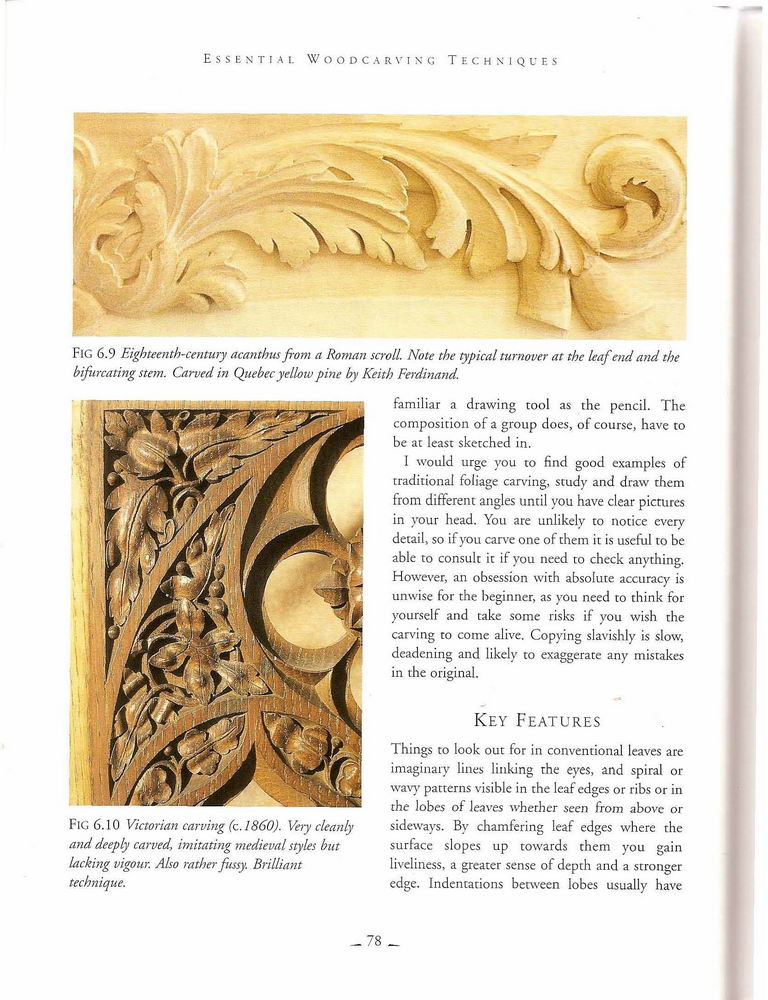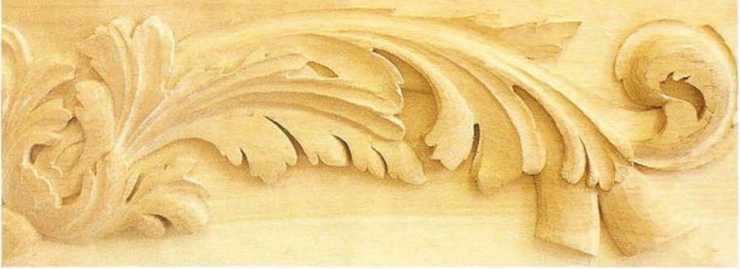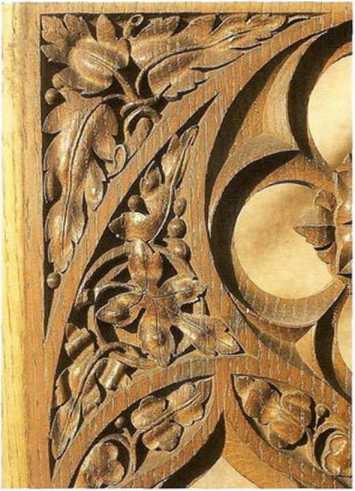essentÊrving°78

Essential Woodcarving T e gh N 1 Q U E s

FlG 6.9 Eigbteenth-century acanthus from a Roman scroll. NotÄ™ the typical turnouer ar the leaf end and tbe bifurcating stan. Carved in Qtiebec yellow pine by Keith Ferdinand.

FlG 6.10 Victorian caruing (z. 1860). Very cleanly and deeply cawed, imitating medieual styles but lacking ińgour. Also rather fussy. Bńlliant techniąue.
familiar a drawing tool as the pencil. The composition of a group does, of course, have to be at least sketched in.
1 would urgc you to find good cxamples of traditional foliage canring, study and draw them from different angles until you have elear pictures in your head. You are unlikely to notice every detail, so if you carve one of them it is useful to be able to consult it if you need to chcck anything. However, an obsession with absolute accuracy is unwise for the beginner, as you need to think for yourself and takc some risks if you wish the carving to come alivc. Copying slavishly is slow, dcadening and likely to exaggerate any mistakes in the original.
Key Features
Things to look out for in conventional leaves are imaginary lines linking the cyes, and spiral or wavy patterns visible in the leaf edges or ribs or in the lobes of leaves wherher seen from abovc or sideways. By chamfering leaf edges where the surface slopes up towards them you gain liveliness, a greater sense of depth and a stronger edge. Indentarions becween lobes usually have
-78 _
Wyszukiwarka
Podobne podstrony:
essent?rving?38 Essential W o o d c a R VIN g Techniques Fic; 2.16 Obeche with pinhole borer damage.
essent?rving?40 Essen tial Woodcarying Techniques FlG 2.20 Arrow Crosstree (Dick Onians), carued in
essent?rving?68 Essen tial Woodcarving Techniques FlG 15.16 The fint cut into the serif on an M. Fig
essent?rving?10 Essentiai. Woodcarying Techniques Makes of Tool Maker/brand Country Edge-
essent?rving?14 pp Essential Woodcarvixg Techniques W Fig 1.17 Ttoo grounders. Very narrow old Engli
essent?rving?20 Essen tul W o o d c a r v i n g Techxiquesmm FlG 1.33 Various rasps: from lefi, two
essent?rving?24 E S S E N T I A L WOODCARYING T E C H X I Q U E S Correct Rocked too far (<â– --
essent?rving?28 Essential Woodcarving Techniques Phloem or bast Bark Wood or xylem Roots anchor the
essent?rving?56 Essential Woodcarvixc Techniques Critical factors in cutting mouldings are the sizes
essent?rving?70 Essential Woodcaryinc Techntiques Fig 5.11 The top surface of the leaffinished, with
essent?rving?84 Essential Woodcarving Techniques Fig 7.7 This is how a piece of card would look if f
essent?rving?98 Essential Woodcarving Techniques Fig 9.1 Various lines. The one on the left Incks in
essent?rving?00 E $ S F. N T l A I. WOODCARVING T E C H N I Q L E S object I wish to draw so that it
essent?rving?14 ESSENTIAL WOODCARNING TECHNIQUES 1 Base flattened before beginning carving. downward
essent?rving?22 E s S E N T I A I. W O O D C A R V I X G T F. C HNIQL ES FlG 11.7 Sejuare bear. Fron
essent?rving?52 Essential Woodcarying Techniques Fig 14.3 Mov mg water. Fig 14.4 Drawings devełoping
essent?rving?15 : ! .20 A student standing at a carmng bench -:: tbe elbow level w
essent?rving?54 Essential Wo o d c a R VIN g Techniques Fic. 4.1 Various mouldings (from the top): a
essent?rving?82 ESSENTIAL W o O D C A R VIXG T E C H N1Q U E S Fig 7.3 Drawings ofa linenfoldpatiem
więcej podobnych podstron